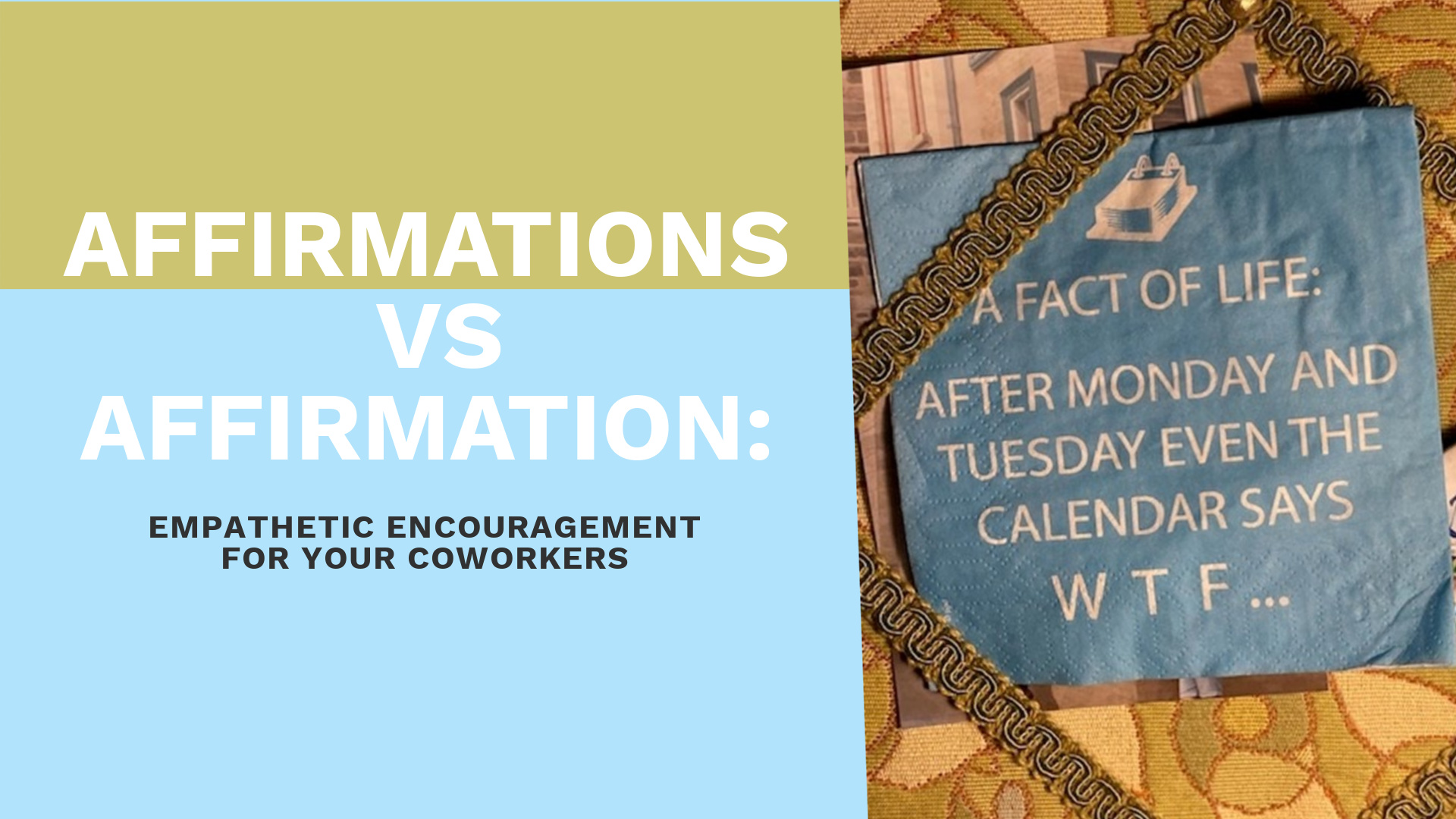By Beth Schaefer, IPD Director

“She leaned forward on the couch, ‘They have affirmations on their walls…’”
– From Maybe You Should Talk to Someone by Lori Gottlieb
The character from the book who says this line is conveying to her therapist why she cannot take any more of her cancer support group: she cannot handle all the positive affirmations.
I am reading Maybe You Should Talk to Someone for my book club. Since this book is an interesting blend of funny and introspective, this line made me laugh out loud, but then… it made me ponder how I encourage others at work.
From my series of articles on being the office curmudgeon, it will not surprise you that the two signs hanging on my home office bulletin board are not positive affirmations, but instead say:
I may have appreciated positive affirmations at one time; I probably even had positive affirmation posters hanging in my middle school classroom (that I am now sure were the source of many teenage eye-rolls), but they have since lost their appeal for me.
At a previous job, when I sat in my boss’s office being told that funding was slim, and I needed to lay-off a staff person, did seeing the waterfall poster in the forest on his wall with the positive affirmation make me feel better?
When one of my staff shared with me that they had been diagnosed with terminal cancer, would they have felt better if I had a calendar hanging on the wall with a mountain scene with this saying?
So, if a positive affirmation is not the answer, what is the correct thing to say?
I do not always have the right thing to say in every moment, but I have 2 resource suggestions that have helped me to move from affirmations (aka: platitudes) to affirmation – acknowledging the person and their emotions in that moment.
1. Brene Brown’s video: Empathy vs Sympathy
I have watched this YouTube video several times – especially when I know that I have someone in my life who needs empathy. I rewatch it because it helps me have a few things to say that actually reflect how much I care for the person. This video helps me meet the measure: first, do no harm. It is hard for someone to accept your helping hand if they feel you have just insulted them or belittled their feelings.
2. Marshall Rosenberg’s book Nonviolent Communication: A Language of Life*
Despite the title, this book is NOT about curbing an urge to hit people but is about empathic listening. I will paraphrase the entire book with a few bullet points, but I encourage you to read the longer version. I have used this communication formula several times with positive results and had meaningful conversations.
- Determine what you are feeling.
- Determine what (not who) is causing those feelings.
- State the why of the feelings.
Example: (A) I am feeling anxious (B) because the shipping order was not placed until Tuesday (C), and I do not think the supplies will arrive on time.
Example: (A) I feel sad (B) that Leo is leaving; (C) he always added humor to our team, but still worked hard for our team’s success.
If you are supporting a team member who is upset or anxious, use the same formula phrased as a question:
Example: Are you feeling anxious because the shipping order placed on Tuesday may not arrive on time?
Example: Are you feeling sad about Leo’s departure because he has been such an important part of our team?
An interesting observation about these resources is that even when I can tell that people are using these affirmative empathetic listening techniques on me, I do not mind. In fact, I appreciate that they are doing the best that they can do to support me in emotional moments.
The next time you have an upcoming difficult conversation, prepare by using a resource to help you empathize and affirm rather than rely on a cliché. Because even though the poster** with a picture of the sunset says,
“Success is a journey. Whatever your path, it is your determination to succeed that will get you there.”
I encourage you to pair that determination with professional development and learn new approaches to truly succeed on improving your empathetic communication skills.
* I do not like the title of this book. Nonviolent Communication sounds like you are navigating boxing matches. Maybe in the next printing they could go with The Art of Empathetic Expression. Besides being a more accurate title, it would sell more books. You can have that suggestion for free Puddle Dancer Publishing.
**Note for the fellow curmudgeons in the crowd, you may appreciate a search in Amazon for Snarky Workplace Posters. I discovered these existed while writing this article. IPD does not receive any money from Amazon.

